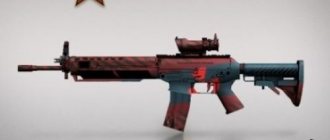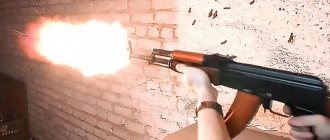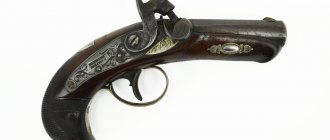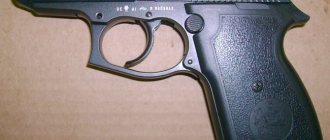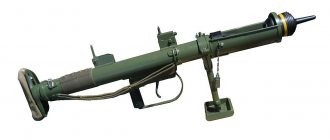Glaive
(French
glaive
),
glaive
- a type of polearm infantry melee melee weapon. Consists of a shaft (1.2-1.5 m) and a tip (40-60 cm long and 5-7 cm wide). The shaft is usually covered with rivets or entwined with metal tape to protect it from being cut. The tip is a blade, it looks like a wide falchion sharpened only on one side. A spike (the so-called sharp finger) extends from the butt of the tip, parallel or directed at a slight angle to the blade, which serves, firstly, to grip the weapon when reflecting a blow from above, and secondly, to apply more effective against opponents clad in armor piercing blows (as opposed to slashing blows delivered with a tip). However, the main purpose of the glaive is still to deliver slashing blows. There was also a tip on the lower part of the shaft (the so-called undercut or heel), but it was usually not sharpened, but simply sharpened - it was used as a counterweight to balance the weapon and to finish off the wounded.
Protective equipment
Topfhelm
Erichonka
- Armor - worn on a person Chain mail - made of woven metal rings
- Armor - made of metal sheets
- Scales (armor) - made of metal plates attached to the base
- Mirror armor - chain mail reinforced with metal sheets
- Laminar armor - made of transverse metal sheets - strips
- Lamellar armor - lamellar armor
Klibanion - Byzantine lamellar armor, complemented by pterigs (leather strips to protect the shoulders) - Brigantine (armor) - made of metal plates attached to the base
- Adagra - leather, in the shape of a heart or two connected ovals
- Armet hemispherical helmet - with folding visor, chin pad and collar
- Grand slam is the same as tophelm
Kabasset helmet - with brim and high crown
- Erichonka - with protection for ears and back of head
Bascinet helmet - according to the shape of the head
How does the law relate to flails?
In the last century, brushes began to appear in a simplified version, which did not have a handle and represented a weight on a chain, or a piece of watering hose with a large nut at the end. Such options became especially widely used in criminal disputes that began after the collapse of the Soviet Union.
Its production, storage and use is illegal. But only forensic examination can determine the characteristics of a weapon, therefore, morningstars certified as souvenir weapons are not such.
But if the examination considers that the presented flail is a bladed weapon, its manufacture and storage will be punishable under Art. 223 of the Criminal Code of the Russian Federation.
What chemical properties does francium exhibit?
The properties of francium are similar to cesium. The relativistic effects of the 6p shell ensure that the bond between francium and oxygen in superoxides (for example, composition FrO2) is more covalent relative to the superoxides of other elements of this group. Taking into account the lowest electronegativity of all currently existing francs, it is characterized by pronounced chemical activity. All physical properties of this element are indicated only theoretically, since it is not possible to test them in practice due to the short “life” period of this element (density = 1.87 g/cm³, melting t = 27 °C, boiling t = 677 °C , specific heat of fusion=9.385 kJ/kg). All compounds of this element are soluble in water (exceptions: salts perchlorate, chloroplatinate, picrate cobaltinitrite francium). Francium always co-crystallizes with substances that contain cesium. Co-precipitation with insoluble cesium salts (cesium perchlorate or cesium silicotungstate) is observed. Extraction of francium from solutions is carried out:
- cesium and rubidium chloroplatinates Cs2PtCl6 and Rb2PtCl6;
- chlorobismuthate Cs2BiCl5, chlorostanate Cs2SnCl6 and cesium chloroantimonate Cs2SbCl5•2.5H2O;
- free heteropolyacids: silicotungstic and phosphotungstic.
Occurrence of carbon in nature
The element and its compounds can be found everywhere. First of all, we note that the substance makes up 0.032% of the total amount of the earth’s crust.
A single element can be found in coal. And the crystalline element is found in allotropic modifications. Also, the amount of carbon dioxide in the air is constantly increasing.
Large concentrations of the element in the environment can be found as compounds with various elements. For example, carbon dioxide is contained in the air in an amount of 0.03%. Minerals such as limestone or marble contain carbonates.
All living organisms contain compounds of carbon with other elements. In addition, the remains of living organisms become deposits such as oil and bitumen.
Fortification
Novgorod Kremlin
Chinese Wall
- Kremlin fortress - Russian fortified city
- Castle (building)
Motte and bailey- European fortress - house of a feudal lord
- Ostrog (fortification) - wooden fortification
The great Wall of China
- part of a fortress or a separate structure
- Gersa - a vertically moving grid
Serpentine shafts
- barrier embankment
Types and their properties
Today, there are several varieties of this raw material, which differ in quality properties, as well as technological nuances relating to production.
Solid
This type is also called natural. Modern manufacturers make it using different amounts of the main components - kaolin and Chinese stone. The first ingredient plays the main role in providing the raw material with such an indicator as strength, but at the same time it is quite unstable to mechanical damage, so it breaks easily. The solid variety usually has considerable weight, such porcelain will not be transparent, and its surface may contain microscopic pores.
The material is obtained through high-temperature heating of the components, as a rule, to obtain raw materials, the mass is heated to an average of 1500 degrees, the firing process takes place in several stages. Initially, hard porcelain will be gray or blue-white; with subsequent processing, the shade of the raw material changes to a more noble one. The components of hard porcelain are not particularly expensive.
Soft
The second variety is called, on the contrary, artificial porcelain. This name is due to the fact that the soft type was first obtained in Europe in attempts to repeat the skills of Chinese craftsmen who made hard material. A feature of the technological process for producing soft porcelain is firing, but when the mass is exposed to less critical temperatures, in light of which the raw material does not completely sinter, but remains porous. Among the notable features, it is worth highlighting the more attractive color of the material, which will be closer to cream.
Another variety is bone and cold porcelain. The first type, in addition to the main components, additionally consists of burnt bone mass; it is durable and stands out for its transparency and whiteness.
Such material also involves the use of a certain technology for firing feldspathic mass with a pre-treated bone component, from which the adhesive component is removed. It is this porcelain that is called thin, since products made from it are distinguished by their thinness.
Cold porcelain was produced by Argentinean craftsmen, who used glue, glycerin, oils, and corn starch as ingredients. The mass is similar in consistency to plasticine and hardens after mechanical action is completed. The raw material is very plastic, therefore it is used for the manufacture of thin and filigree products. The material is sold in finished form.
Advantages and disadvantages of falchions
Due to the fact that this weapon was very popular, many examples of falchions of various types have been found. The advantages of this weapon were as follows:
- Ease of manufacture;
- The possibility of converting an ordinary peasant cleaver into a falchion by reforging and changing the shape of the blade tip;
- The shifted center of gravity and the large weight of the weapon made it possible to deliver fairly strong blows;
- Maneuverability and efficiency in confined spaces;
- Since the weapon was held with one hand, the other remained free for a shield or a second weapon.
Despite a lot of advantages, the falchion also had several serious disadvantages:
- While a sword could be used to thrust, a falchion of any of the basic types was a purely slashing weapon. They could only stab an enemy unprotected by armor;
- If a warrior fought one-on-one with an enemy armed with a sword, then to win he had to be much more experienced, since it was much more difficult to deliver a fatal blow with a short weapon;
- The need for a wide range of movements to strike greatly reduced the effectiveness of the falchion in dense formation.
Production and processing
Once consumable ingots are formed, they are transported to the smelter. Next comes testing, preparation, and cleaning. Stages of production of gold and silver from Dore alloy:
- To determine the composition of the products, they are melted. Workers take samples to determine the exact amount of components contained in the compound. If there are no deviations or elements that make cleaning difficult, the material is sent for further processing.
- Initially, Dore alloy is purified from 5% of impurities. To do this, it is melted, soda and quartz are added, and blown with a powerful stream of air.
- Third-party components are fused with quartz. Slag is formed and removed from the surface of the molten metal.
The procedure is repeated several times. The resulting mixture is treated with carbon-containing compounds. This is how pure silver and gold are obtained. Next, the materials are poured into molds to form ingots. After this, they are released into further production. Before marking finished products, the purity of the metal is checked. To do this, they are melted and a sample is taken. Then they solidify, the ingots are weighed, and markings are applied to the front side.
Dore alloy is melted down consumable raw materials, the basis of which is gold and silver. In addition to noble metals, the mixture contains third-party components that must be removed to obtain individual materials. Raw materials are used in the manufacture of parts for electrical appliances.
I get gold from stones...GOLDEN CHANNEL...
Watch this video on YouTube
FAQ
Where can I find a book on blacksmithing?
In any bookcase. You can buy it in the purchase mode (“Sorting by purpose / Wardrobes and chests of drawers”) or use what’s in the castle. Then you need to “View” its contents. When the priest says that the book you need is not in the closet, you can buy it in the village shop.
What material should the first sword be made of: mithril or obsidian?
From the one that is more in the blacksmith's luggage. In the end, he will still make a sword from an alloy of these two metals.
How to test the sharpness of a blade using a whetstone?
Click on the sword in your luggage and select the “Sharpen Blade” option.
How do I create two written copies of benefits?
Using the desk, which can be purchased in the purchase mode ("Sorted by purpose / Household / Professional") or use the desk in the castle.
How to send a request to the Great Inscription?
Using a mailbox.
How to learn the ancient Pektarik language?
With the help of the priest's archive.
How to research metallurgy as a blacksmith?
With the help of the priest's archive. For example, standing in a city square.
How to prepare a divine catalyst?
In a forge or a regular hearth, there will be a glitchy option without a signature.
Which sword is better to choose from the two options at the very end?
It doesn’t matter, the hero won’t get it anyway.
Navy
Drakkar
Galleon
Junk
- European Brigantine - light sailing vessel
- Galeas - large galley
- Galleon - a multi-deck sailing ship with cannons
- Galera - sailing and rowing ship
- Drakar - Scandinavian boat for 100-150 people
- Dromon - Byzantine bireme
- Caravel - medium-sized sailing ships
- Karakka - a large sailing ship
- Ladya (ship) - Slavic boat for 60 people
- Scampavea - sailing and rowing ship
- Strug - Russian river sailing and rowing vessel
- Shebeka - sailing and rowing warship
- Shneka - sailing and rowing vessel
- Ushkuy - Russian sea and river sailing and rowing vessel
- Flute - sailing ship
- Rowing frigate - sailing and rowing ship
- Chaika - Cossack boat
- Asian Atakebuna? (en:Atakebune) - Japanese
- Tower ship (en:Lou chuan) - Chinese
- Jonka - Chinese ship
- Turtle ship - a durable Korean ship
- Red seal? (en:Red seal ships) - Japanese ship
- Mongolian ship? - the ships of the Mongols on which they sailed to the Japanese
- Panokseon (en: Panokseon) - Korean
Modifications
In China, there were even three-bladed types of individual weapons - a long blade with two places for gripping with hands, which could be used to strike with both ends of the blade and with part of the blade between the grips.
There were various modifications of the glaive: from identical double-edged narrow long blades at both ends of the shaft, to a wide, ax-like tip at one end and a simple spherical counterweight at the other. A two-blade modification of the glaive (with blades at both ends of the shaft) is extremely rare. There are about 100 modifications of the glaive in total.
The glaive has been used as a personal weapon since the 14th century, in particular as the personal weapon of crossbowmen in Burgundy [ unauthorized source?
]. It showed itself well as a weapon for repelling cavalry attacks. Until the 18th century it was used as a weapon for the palace guards, then fell out of use.
The closest analogues of the glaive are the halberd, the berdysh, the axe; naginata (Japan), guandao (China), bhuj (India), sovnya (Rus), palma (Siberian peoples), nagamaki (Japan) are given as possible analogues.
In literature and art
A man with a glaive in a quilt and chaplain
Creativity of Nick Perumov
The glaive is mentioned as the favorite weapon of the protagonist of Nick Perumov’s pentalogy “Keeper of Swords” Kara Laeda, aka the warrior of the Gray League Fess, aka the necromancer Tawny Owl. It should be noted that the glaive of Fess is not a typical representative of glaives: firstly, it is two-bladed (with two chopping tips at both ends of the shaft); secondly, it is short and very light (unlike a real glaive, which was a heavy weapon, not at all intended for filigree fencing); thirdly, Fess uses it without problems in basements and caves[5], which is uncharacteristic for long polearms; fourthly, it is possible to repel an arrow fired at point-blank range with a heavy long glaive only by pure chance; fifthly, the glaive of Fess was detachable, that is, it was divided into two separate short swords.
Because of the work of Nick Perumov, many [ who?
] imagine the glaive to be exclusively two-bladed, whereas in reality two-bladed weapons with blades at both ends of the shaft were almost never encountered.
Chinese iconography
The glaive (guan dao, yanyuedao, dadao) is a constant attribute in the images of Guan Yu, a military leader of the Three Kingdoms era (III century).
Physical and chemical properties of glycols
Lower diatomic alcohols (ethylene and propylene glycol) are colorless transparent liquids. The presence of polar hydroxyl groups affects the physical characteristics of the substance - high density, viscosity and thermal conductivity.
Ethylene and propylene glycol are highly soluble in water and organic solvents - carboxylic acids, ketones, amines, alcohols. Lower glycols are used as solvents for most organic compounds except higher saturated and aromatic hydrocarbons.
The chemical properties of diols are similar to monohydric alcohols. When interacting with metals and their salts, they form alcoholates; when combined with acids, they form ethers and esters. Each polar hydroxyl group undergoes a chemical reaction independently of each other, resulting in a mixture of products.
A little history
Most sources indicate that the birthplace of porcelain is China. The emergence of this raw material dates back to the period VI-VIII centuries AD. e. For many years, the formula and composition of this material were kept secret, and interesting decoration techniques, including “rice porcelain,” were born there. In Central Asia, porcelain products appeared around the 9th century; 7 centuries later, the technology for manufacturing unique raw materials became known to Japanese craftsmen, and later porcelain production began in Europe.
The history of the creation of Russian porcelain dates back to the 18th century, but initially this material was similar to earthenware in its technical characteristics. The establishment of the production of porcelain products in Tsarist Russia had two directions - in those days, private manufactories functioned, and the production of products from this raw material was also established under the leadership of the royal dynasty.
Among the most famous facilities that are still in operation today, it is worth highlighting the Imperial Porcelain Factory, where small items such as tea sets, snuff boxes and buttons for the Empress were originally made. With the advent of Soviet power, private factories were nationalized, and many manufacturing technologies were lost.
As for the European direction in the history of porcelain, the first masters trying to create this material were the Italians. The British, French and Germans also tried to succeed in this matter. However, they did not manage to achieve the same result as the Chinese right away.
The first samples of European porcelain were more like glass. A real breakthrough in this direction was made in Germany, where the young alchemist Böttger and physicist Walter von Tschirnhaus discovered large deposits of white clay, which was fundamentally different from other fossils in its plasticity.
Basic information
One of the most proven methods of connecting two parts is considered to be a tongue-and-groove connection. This method of fastening wood products is the most widespread. It is used to fasten parts of window frames, doorways, various furniture elements, and the walls of wooden boxes. Each element of such products has a specially made tenon (or several pieces) or a groove (several grooves).
The types of main connections of parts made of wood are defined in GOST 9330-76. This document defines the following characteristics of such fastening of wooden parts:
- rules for abbreviation (abbreviation) of various compounds;
- drawings showing the appearance;
- permissible dimensions of each element;
- the procedure and rules for determining the size of each element;
- expressions for calculating the dimensions of the required cutting tool;
- formula for calculating the strength of assembled elements;
- inspection procedure and strength testing.
GOST 9330-76 Basic connections of parts made of wood and wood materials. Types and sizes
1 file 285.82 KB
According to this standard, all connections are divided into the following categories:
- corner (end and middle);
- box (mainly belongs to the corner category);
- along the edge;
- the so-called “on the mustache” length.
For each of these categories, the standard has its own abbreviation (short designation). This marking consists of two capital letters of the Cyrillic alphabet and one number. For example, UK-2 means that we are talking about a connection with a double open end-to-end tenon, UK-9 is a “mental” connection with a plug-in non-through round tenon. The entire list is set out in more detail in the text of the adopted standard.
Any type is accompanied by a detailed drawing. Each of them shows frontal and profile projections indicating dimensions, formulas for calculating each element, and finished results. To obtain a strong connection, the standard defines tolerances that must be observed in the manufacture of each element. The parameters of the corner tenon (its length, pitch and bluntness) are given in detail. Based on the results presented, the guest developed recommendations for choosing the necessary cutting tools. Separate references are made to other documents (standards) that determine by what means each of the listed products must be secured.
Types of finger joints
Today, a wide variety of such methods for fastening wooden parts has been developed. All types of tenon joints are classified according to the following criteria:
- number of spines;
- their form;
- eye depth (through or not);
According to the first sign, tenon joints are: single, double, multiple. It determines the number of fasteners produced. The main forms of the spike are:
- rectangular (has different lengths, pitch and apex angle);
- round;
- triangular;
- so-called “dovetail” (one-sided or two-sided);
- gear (with different angles of inclination);
- angular.
The choice of shape and size depends on the material used and the level of load that the entire structure must withstand. A tenon joint with many rectangular tenons has become widespread. Its main advantage is considered to be ease of manufacture and the ability to use it for any wood.
Climate
Rice. 7. Climatic zones
The formation of the climate of the Far East was influenced by its coastal location. It is located in the Arctic, subarctic and temperate climatic zones. Monsoon circulation of air masses plays an important role. The southern part is characterized by a monsoon climate with high rainfall, most of which falls in summer. Summer monsoons are associated with floods and flash floods on Far Eastern rivers.
Rice. 8. Climatogram of Petropavlovsk
Kamchatka and the Kuril Islands are located in a temperate maritime climate, characterized by mild winters (-8-10°) and cool summers (+12° in Petropavlovsk-Kamchatsky). The climate of the Chukotka Highlands is one of the most severe in the Far East. Winter is long (7–8 months), summer is short and cool. The average temperature in January is from -15° (in the south-east) to -30°C (in the north-west), in July - from +3° in the north to +10°C in the south. Precipitation ranges from 250 to 400 mm per year.
Rice. 9. Climatogram of the Chukotka Highlands
Other
Use of Greek fire. Miniature of the Madrid copy of the Chronicle of John Skylitzes.
- Gulyai-Gorod - Russian mobile defense system
- Greek fire - Byzantine incendiary weapon, prototype of the flamethrower
- Cavalry - the use of horses in war
- Lariat or Lasso - throwing loop
- Trap - a device for catching or damaging legs
- Garlic (anti-horse fence) - spikes for damaging hooves
- Slingshot (barrier)
Spanish horseman (en: Cheval de frise) - in particular, crosswise spears are used- reinforced stakes against cavalry
- Blowpipe - for throwing mostly poisoned spikes using air pressure
- Combat chain - a weapon in which the striking element is a chain, sometimes with spikes
- Whip, Whip
Bako (whip) - Chinese whip- impact element - leather, rope, rod or cane
- Whip
Nagayka - Cossack and Tatar— shock element — intertwined leather straps
- Poison - has a poisonous effect
Manufacturing materials and device
The flail is a percussion-crushing weapon consisting of a striking part, suspended on a flexible belt from the handle or without it.
Only morningsterns have some variety in appearance - this weapon was often used as an additional weapon by knightly cavalry and therefore differed for the better from the weapons of commoners.
Since the device of the flail is very simple, we will reduce it to one list:
- lanyard or extinguisher - an additional device for comfortable grip into which the hand is threaded. The material used was animal skin;
- handle (handle) - a device for gripping, the most common version was made for gripping with one hand, but there were also those that allowed you to work with both one and two hands. The most popular material was wood, but there were also metal ones. Often, for ease of carrying, flails were made without a handle; in this case, it was replaced by a damper - a loop through which the hand was threaded;
- connecting link (belt) - a flexible part designed to connect the handle with the striking part. There are not many options for materials: rope, leather belt, metal chain;
- flail (weight) - the beating part of the weapon, made of bone, stone, various metals, and occasionally wood was used. Often the load had convex spikes or ribs to increase the traumatic effect. In addition, the morning stars used by nobles were often decorated with family coats of arms and engraving.
Throwing weapon
Composite bow
- Bow - for throwing arrows due to the tension force Long bow - more than 7 dm Long English bow - 1.7 - 2.1 m, arched
- Long Novgorod bow - from 1.9 m, M-shaped
- Japanese longbow - 2.1 - 2.5 m, asymmetrical
- Crossbow - European crossbow
Throwable weapon
- Throwing knife - a knife adapted for throwing
- Lightning (weapon) - African throwing weapon
- Shuriken - Japanese throwing weapon, usually in the shape of a star
- Tomahawk - North American ax
- Franziska - European throwing ax
- Khelbat - European throwing hatchet
- Chakra (weapon) - Indian throwing ring
- Throwing Mace
Boomerang - a curved throwing club, some are capable of flying in a back-and-forth trajectory- a mace adapted for throwing
Etymology and transformations of semantics
The Dukes of Berry and Burgundy leave Paris to meet the Duke of Brittany, accompanied by bodyguards armed with glaives. Miniature from Froissart's Chronicles
The name comes from the French language. Almost all researchers trace the etymology of this word to Lat. gladius or to Celtic [ specify
]
cladivos
- sword. However, all early English and French references to a glaive imply a spear. This is what is meant by a glaive in English from about the 14th to the mid-16th centuries. The word has acquired its current meaning since the 15th century. Around the same time, the glaive poetically referred to the sword as a whole (this is the meaning in which the word is most often used in modern French).
Early glaives were presumably simply swords or falchions mounted on long shafts, or their blades.
Since the 1980s. A glaive is also a name for a fictional multi-bladed throwing weapon, similar to the shurikens of Japanese ninjas, only larger. Often, such weapons are attributed the ability to return to the thrower (magically or according to the boomerang principle). Throwing glaives appear on the pages of fantasy literature and feature films (for example, the five-petalled glaive from the movie “Krull”), in the computer games Dark Sector, Torchlight 2, Warframe and Dungeon Siege II.
SPEARS
A spear
They began their journey with the Scythians, and were considered cavalry. They had a blade. They were used in hand-to-hand combat and were also a throwing weapon.
When a spear was used by a rider on horseback, it was held with one hand. It was customary to strike from top to bottom. In case of a miss, this position made it possible not to lose balance and not be left without a steed. The blows were still struck with a blade.
The Romans, Persians and Greeks preferred to leave these tactics unchanged.
During the reign of Alexander the Great, causing damage with a blade received the greatest development. To facilitate the use of copies, modernization decisions were made. They began to be attached to the saddle using straps made of leather. A little later they were made more fragile.
The next round of modernization was the burning of the blade. Firing made it stronger and at the same time dull. Some time later, a blade was made from stone, and hunting for larger animals began.
Over time, modernization also affected the tip. They began to produce it in leaf- or diamond-shaped form.
The spear has become extremely widespread both in the army and among civilians, thanks to its cheapness and ease of manufacture and use.
The spears caused great damage only to opponents who did not have good defense.
Spears[edit]
- Since the Bronze Age, the spear has been the main weapon of all mass infantry from the Sumerian phalanx, to the classical phalangite of Hellas and the Roman legionnaires with pilums. The same army could have up to a dozen different types of spears in service.
- In the Scandinavian sagas there are many examples of how a foot warrior went into battle with a spear in order to hit infantrymen with it. But we are again talking about a non-classical, shortened spear, like a spear (see the next paragraph). Continental Germans have been armed with a similar spear since Julius Caesar. Its Frankish variety was called frameya.
- In Europe, both cavalry and infantry of the Renaissance used pikes, as both had a critical need for armor penetration against heavy cavalry.
- In the Polish-Lithuanian Commonwealth, mounted Cossacks periodically used spears, but then from the end of the 16th century they switched to pikes, but the Lithuanian Circassians of Pyatigorsk did not abandon the spears.
- Boarding pikes continued to be used when they had long since been completely replaced by the bayonet in the infantry.
- By the way, the spear is perhaps one of the best types of improvised throwing weapons. An experienced thrower can even spin the spear around its own axis, increasing its penetrating power.
Receiving an item
Can only drop from Guardians of the Ancient. Cannot be obtained from an Orb of FortuneOrb of FortuneStack Size: 20Upgrades a normal item to a random rarityRight click this item then left click a normal item to apply itShift click to unstack.
Restrictions on receipt in the regions
This item can be obtained in the following areas:
- The heights of the hassle
- Halls of delirium
- Islands of Ruin
- Madness Manor
- Wasteland of madness
- Desert of Madness
- The abyss of loneliness
- River of Hysteria
- Ruins of Despair
- Warehouse of mockery
- Vaults of Madness
- Pits of Sorrow
This item can drop from the following monsters:
- Eradicator
- Redeemer
- Enslaver
- Oppressor
Used to obtain
This item is used to obtain the following items:
| Result | Qty | Ingredient | General Notes | Type |
| ArborixArborixAssassin's BowBowQuality: +20%Physical Damage: (150-174)–(394.8-424.8)Critical Strike Chance: 6.70%Attacks Per Second: 1.25Weapon Range: 120Requires Level 62, 212 Dex+(15-25)% to Global Multiplier Critical StrikeAdds (95-115) to (240-265) Physical Damage(60-100)% increased EvasionBow Attacks fire 2 additional ArrowsEvery 16 seconds you gain Nerves of Steel for 8 seconds30% more Damage with Close Range Arrow Hits, while you are affected by Nerves of Steel30% increased attack, cast and movement speed while you are not affected by Nerves of SteelYou get a Long Shot while you are not affected by Nerves of SteelDry, floods, fires, cold - everything is nothing to those age-old giants who are strong in their the mighty grip of depth entwines the dark earthly. | 1 | Greelwood ThornGreenwood ThornEternal SwordOne Handed SwordQuality: +20%Physical Damage: (125.05-137.35)–(207.4-227.8)Critical Strike Chance: 5.00%Attacks Per Second: (1.72-1.80)Weapon Range: 11Requires Level 66, 104 Str, 122 Dex +475 Accuracy(185-215)% increased Physical Damage(15-20)% increased Attack Speed80% increased Armor while standing in one placeSkills fire 2 additional projectile(s) if you've been Hit RecentlyPoint-Blank ShootingNerves of Iron while standing in in one place They stand adamantly for countless years, although every year leaves marks on them and writes memoirs on the calloused flesh. | objects should not be desecrated | Manually |
| 1 | Beltree BladeBeeltree BladeEternal SwordOne Handed SwordQuality: +20%Physical Damage: (125.05-137.35)–(207.4-227.8)Critical Strike Chance: 5.00%Attacks Per Second: (1.72-1.80)Weapon Range: 11Requires Level 66, 104 Str, 122 Dex +475 Accuracy(185-215)% increased Physical Damage(15-20)% increased Attack Speed80% increased Evasion while movingSkills fire 2 additional projectiles if you have recently used a move skillLong ShotThey are carried by the winds and wings, they their fates are beyond their control, much less the fates of those around them. | |||
| 1 | Orb of FusionOrb of FusionStack Size: 20Reforges an item by changing the links between socketsRight click this item then left click a socketed item. The item's quality value is consumed to increase the chances of obtaining additional connections. Shift-click to split. |
How does the weapon work?
A glaive is a weapon that consists of a shaft reaching one and a half meters and an elongated tip. As a rule, a tip was made with a length of at least 40 cm, but sometimes it could reach 60 cm. The width of the tip was five to six centimeters. Making a weapon is not at all difficult, so it is possible to create it at home.
The shaft was wrapped with a metal tape or covered with special metal rivets. Thanks to this manipulation, the wood was protected from cutting in battle. In most cases, the tip was sharpened on only one side. A spike extending from the butt and going towards the shaft at a slightly angle is a characteristic feature of gleyvia. If the glaive was used to repel a blow from above, then such a spike was used to capture an enemy weapon. In addition, the spike enhanced the result of piercing blows to the opponent’s armor. In general, the glaive was intended for slashing blows, and they were delivered with the tip.
At the bottom of the gleevia shaft it was equipped with another small tip, which was called the underflow, or heel. Unlike the main tip, it was simply sharpened and not sharpened. This tip had two purposes: it helped balance the weapon in battle, as it played the role of a counterweight, and in addition, it was a weapon with which to finish off a defeated warrior.
Polar "cousins"
These examples of medieval weapons are so far removed from their ancestors that, perhaps, only the presence of a shaft makes them similar to their ancestors.
Lucerne hammer
It is very similar in appearance to a halberd, but the spike-hook (or hammer) on the butt is usually larger in size and bent down, and the ax handle is replaced by a hammer head. The firing pin is very narrow and, as a rule, not flat, but made in the form of three or four teeth to prevent slipping upon impact. Thanks to its small impact surface and strong swing, the Lucerne hammer is capable of punching holes in any armor. Compared to the halberd, the Lucerne hammer is somewhat less effective, because its firing pin plunges into the entire length of the enemy’s body and, as a result, can become firmly stuck and temporarily disarm its owner. On the other hand, if a halberd can slip off an enemy’s shield or helmet with an oblique blow, the Lucerne hammer does not have this drawback - if a hit occurs, then this hit is guaranteed to inflict a mortal wound on the enemy.
The length of the Lucen hammer reaches 2 meters.
Klevets (minted, bec de corbin)
Mistakenly called a “reed,” this version of the Lucerne hammer is distinguished by a “spear” tip (but more often without it at all), a wider striker and the replacement of the hook blade on the butt with a second striker, but not serrated, but sharp. The Bec de Corbin is shorter and more suitable for hand-to-hand combat, and also, unlike the Lutzernhammer, can be used as a non-combatant weapon, but as an individual weapon.
The following samples are classified by different classifications as either one or another “parental” type. To avoid creating confusion, I give their names separated by a dash.
Mower-guizarma
“Mutant”, combining the properties of a mower and a guizarma - from the first the shape of the blade was inherited, from the second - a hook on the butt sharpened on the inside.
Glaive Guizarma
Another attempt to create a universal weapon by combining two “specialists”. The blade of the glaive has become more massive, and the already familiar hook is attached to the butt. The result of the work was a good replacement for a halberd - inferior in efficiency, but widespread and easy to use.
Guizarme-Voulge
Again a “station wagon”, bristling with blades in all directions. The Vulge blade is complemented by a grappling hook, giving it a full range of capabilities - from slashing and piercing blows to the ability to effectively fight cavalry.
Bill-guizarma
Most of all it resembles an open Swiss Army knife on a shaft. The creators of this weapon were very inventive - judge for yourself, in one design everything that can be “squeezed out” of a polearm weapon is combined: a spear tip, a hook, transverse blades for blocking enemy weapons, a wavy surface for inflicting fatal wounds... All this had to be paid for weight - for bill-guizarms it is significantly higher than the weight of any of the types of progenitor weapons.
Economic-geographical location
The economic and geographical position is characterized by:
Firstly, the huge distance from the European part of Russia. The distance from Moscow to Vladivostok along the Trans-Siberian Railway is more than 9,300 km.
Secondly, the presence of such neighbors as Southern and Eastern Siberia, which have large reserves of natural resources.
Third. The Far East is part of the Asia-Pacific region - a single economic space of the countries of America and Asia, which makes it possible to carry out economic cooperation with the countries of this region.
Rice. 3. Pacific Fleet
Fourthly, the Far East has a very important geopolitical position for our country. The Pacific naval fleet is based here, which ensures Russia’s interests in the Pacific basin
Important transport routes connecting East Asia and the western coast of America with European countries pass through the territory of the Far East. The features of nature are determined by the geographical location of the Far East. Its northern regions are located beyond the Arctic Circle, and its southern regions are located at the latitude of Italy.
The role of carbon in the human body
Carbon enters the human body along with food, during the day - 300 g. And the total amount of the substance in the human body is 21% of body weight.
This element consists of 2/3 muscles and 1/3 bones. And the gas is removed from the body along with exhaled air or with urea.
It is worth noting: without this substance, life on Earth is impossible, because carbon makes bonds that help the body fight the harmful influence of the surrounding world.
Thus, the element is capable of forming long chains or rings of atoms, which provide the basis for many other important bonds.
How the glaive was used
The main advantage of the glaive, as well as any other long-armed weapon, was its significant radius of destruction. A warrior armed with a sword, sword, mace or ax is unlikely to be able to reach an infantryman who has a glaive in his hands. They rarely stabbed with this weapon, much more often they cut. In close formation, a warrior with a glaive mainly struck from top to bottom, but if he had free space, his arsenal of combat techniques increased significantly.
In this case, it was possible to use the middle and lower part of the shaft, its opposite end. Like any long-armed weapon, the glaive had a weak point. Her blow could be reflected with a shield or intercepted by the shaft with a hand, which led to the disarming of the warrior. It is clear that the glaive was not very effective in close combat.
Well, one last thing to add. The glaive was a heavy and powerful weapon designed to defeat a heavily armored warrior. So she was not very well suited for filigree fencing.
Falchion - truth and myths
There are several myths associated with this weapon that are only half true. For example, it is widely believed that the falchion was always made of low-grade steel and was never used by wealthy nobles. The second myth says that only mercenaries and robbers fought with the falchions. In fact, initially these weapons were of really low quality, but often mercenaries who used these blades in battles managed to become elite warriors, and some could later even become knights.
The second fact, which suggests that noble knights did not disdain these blades, is the documents that have survived to this day, which describe in detail the technique of wielding a falchion. These documents were found in the libraries of ancient knightly families in Europe. According to them, combat techniques were studied from the age of 7. At the age of 14, the future knight already mastered weapons perfectly and began to study various secret blows and techniques that were never used in public duels.
Although the falchion remained a common weapon that was not made famous in poems about knights, its contribution to the history of the Middle Ages should not be underestimated. From documentary sources it can be found out that the feudal militia and mercenaries, who together made up the majority of the medieval army, were armed with precisely this weapon, and it was even more popular than the axe. It is interesting that in Rus' these blades were practically unknown, since the ax reigned there, which eventually gave way to the saber.
Author of the article:
ULFHED
I am interested in martial arts with weapons and historical fencing. I write about weapons and military equipment because it is interesting and familiar to me. I often learn a lot of new things and want to share these facts with people who are interested in military issues.


